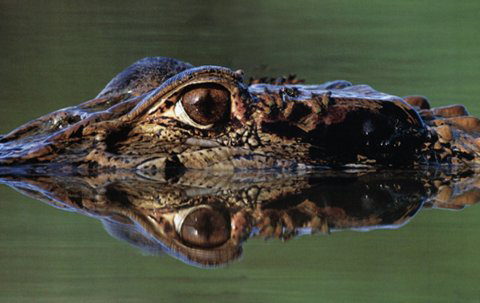
Frans Lanting. Illustration by Joanne Young.
Way back in the depths of February I went for a very different night out in the middle of London Fashion Week. This was for the London premiere, at the Barbican, of an unusual multimedia collaboration between composer Philip Glass and Frans Lanting – a wildlife photographer much beloved of the National Geographic. LIFE: A Journey Through Time comprised an orchestral performance by the London Symphony Orchestra played beneath a huge three screen projection of photographs depicting the evolution of life on earth: not a big task at all then. The images have also been turned into a beautiful (and heavy) coffee table tome produced by Taschen, which is available here.

You wouldn’t want to drop this on your toes.
When I was I child my parents seemed hopeful that I’d become a serious violinist, so at the weekends I was dragged on numerous trips to watch classical music performed at the Royal Festival Hall and ever since then the idea of doing the same under my own steam brings back memories of mind-numbing boredom. What a great idea though – create something for those of us more visually inclined to look so that our minds don’t wander too far. I was hoping that the combination of imagery with music would produce something so much more engaging than your usual orchestral performance.

I was not disappointed: from the upper gallery we had a great view of the screens onto which were projected a mixture of stunning images from Lanting’s back catalogue together with many that were specifically taken for this project, one which clearly necessitated many further trips into pristine wildernesses to capture the world as it might have been many years before man arrived on the scene. The music and the images were expertly ‘choreographed’ by Alexander Nichols for the first ever performance, held in 2006 in Santa Cruz, and have been altered and adapted at each ensuing one. LIFE: A Journey Through Time has now been performed all over the world, including at the official inauguration ceremony of the CERN Hadron Collider. You can watch an excerpt of the show here.
After the performance we stayed on for a Q&A session, which was unexpectedly interesting – possibly due to the high calibre of the audience questions – a rarity! Together, Franz Lanting (the man with the idea), conductor Marin Alsop and Cameron Hepburn, an environmental economist and representative of Julie’s Bicycle (on organisation that seeks to reduce the carbon emissions of the music industry) talked about the processes and ethics behind the performance.

Image courtesy of Frans Lanting.
The extreme luminosity of the projections were perfect for showcasing the impressive images, which somehow took on an otherworldly feel despite being very much about our own amazing earth. Lanting did his best to find images that look hyper real in the first place, which of course has been abetted by the move to digital photography. “All the most recent images were taken on digital cameras and the colour of earlier ones were synchronised with them.” No longer do we need to worry about the quality of “crummy prints.” The project was only supposed to take a few years to do, but unsurprisingly Lanting kept finding new and interesting things to photograph. How does he locate and then shoot his subject matter? “It takes a lot of patience and research; finding out where and when to go to a place. You can’t just sit behind a tree and hope for the best – you have to engage and then get out of the way quickly.” He offered as an example the yawning jaws of a hippo. No, you wouldn’t want to stay too close to that particular vision!

Image courtesy of Frans Lanting.
The biggest issue for Lanting was how to weave the human story into such a beautiful project without really, erm, sullying the imagery with shots of actual humans. Seems I’m not the only one who regards us as a blight on the planet. He decided that the best way to do this was to subtly represent the vulnerability of humanity with an image of an embryo, a curiously delicate pair of human feet, and cross sections of brain and hands to highlight the universal branching patterns that can are found everywhere in nature, from landscapes to music. Setting the imagery to music made perfect sense because everyone can relate to music in the same way that they can relate to the natural world. “Resonance is indigenous to life, so the same patterns repeat themselves at different scales in whatever form.”

Image courtesy of Frans Lanting.
And this is where the choice of Glass came in. “Selecting the composer for this work was a logical decision,” explained Lanting. “I’d had his music in my ears for decades because it has the same organic focus on pattern as you find in the natural world.” And anyway Steve Reich won’t work with an orchestra, so that put paid to his inclusion in the project.

Marin Alsop. Ilustration by Joanne Young.
As for the conductor, Marin Alsop. Well, I and most of the audience were most surprised to discover that there was no automatic synching of the music to the imagery – she does it all done totally live. “It’s quite a tricky thing to keep in time with the images,” she admitted. No shit! I was seriously impressed. Added difficulties arise when the images are changed around from performance to performance. “Sometimes I’m looking for an iguana and it’s become a bird.” She tries to keep in time by doodling eyeballs in the correct places on her score, although she admitted that “it’s mostly just luck when everything lines up.”

Cameron Hepburn. Illustration by Joanne Young.
So why do this? Why put together this piece and then tout it all over the globe? “It’s all about humanity being in the same place experiencing something together at the same time” was the best that the panelists could come up with. This is where I struggle. It’s a beautiful piece of work and one that I would highly recommend anyone to go and see – it’s evocative, engaging, mournful, emotional. But the creators are also being flown all over the world to promote the piece, which in itself is a carbon intensive production. Because I feel so very conflicted about projects like this I was really interested to hear the thoughts of Hepburn, who admitted that although he cycled to the Barbican he also flies around the world to attend conferences on climate change. He was also disarmingly honest in questioning how successful this performance could be in raising awareness of climate change and the attendant huge loss of biodiversity that we currently face.

Image courtesy of Frans Lanting.
Yes the performance was incredibly moving, and the accompanying book is very beautiful and I’d really like a copy, yes please, as did many of the punters queueing around the shop to buy it – but what exactly will its purchase do, apart from provide a bit of wow factor for the coffee table? Having enjoyed this performance, will the audience go away and change anything deeper about their lifestyles? Am I a cynic to doubt they will? The main demographic were assuredly middle class cultured types of the sort who think nothing of flying half way across the world on holiday and then assuage their conscience by staying in an eco-lodge. Does this really help preserve the glory of our natural world? I am sure that the production of this work alone has justified Lanting’s global jaunts to fragile places of beauty many times over. Therein lies the conundrum: it’s important to document and tell people about what we risk losing and Lanting is particularly good at capturing the raw primeval beauty of the natural world – but when the very production of those photos contributes to global warming, where does that leave us?

Image courtesy of Frans Lanting.
Humans are programmed to rejoice in the wonder of the natural world; it’s why we love to travel abroad and experience the landscapes of beautiful unspoilt places. I love being in wild places so much that it was one of the reasons I decided to pursue fashion photography for a while – it allowed me to seek out amazing locations that I would never otherwise have been able to justify visiting. But we’ve become so greedy to see all the beautiful places of the world that we bury our heads and do our best not to consider the heavy carbon costs of air travel. How many people actually think about what that holiday to a pristine wilderness now costs us on a planetary wide scale? And how do we balance having a global view not only of the beauty we risk losing, but the multitudes of cultures and peoples, whilst taking into account the costs of travel?

Image courtesy of Frans Lanting.
I don’t know what the answer is. If I’m honest I’m jealous that Lanting has a reason to justify his visits to the Galapagos and I don’t. But would I fly there repeatedly if I had the opportunity to do the same? Probably not. My conscience just weighs too heavy. Although maybe I can justify just that one trip for myself in my lifetime… Now how long does it take to get there by boat?
Categories ,barbican, ,Cameron Hepburn, ,CERN, ,Classical Music, ,Frans Lanting, ,Galapagos, ,Hippo, ,Joanne Young, ,Julie’s Bicycle, ,London Fashion Week, ,London Symphony Orchestra, ,LSO, ,Marin Alsop, ,Minimalist music, ,Philip Glass, ,photography, ,Royal Festival Hall, ,Santa Cruz, ,wildlife
Similar Posts:
- Photography exhibition: ‘New York Sleeps’
- Elizabeth Johnson. An Interview with a Photographer
- Some Trace of Her
- The Sixties: Photographs By Robert Altman
- Project Recycle- time to get creative!






